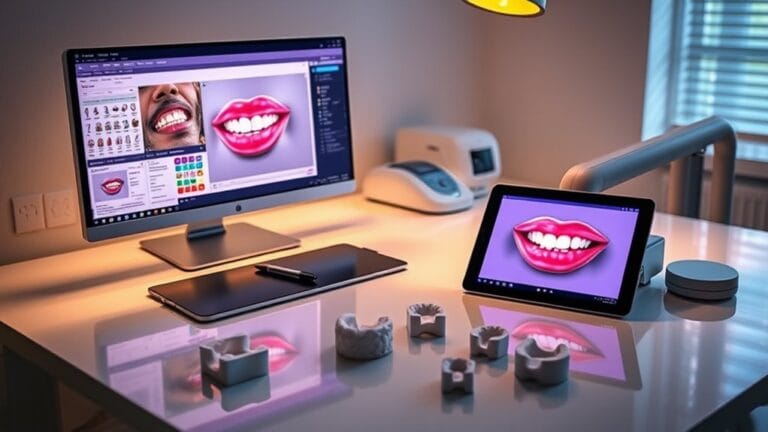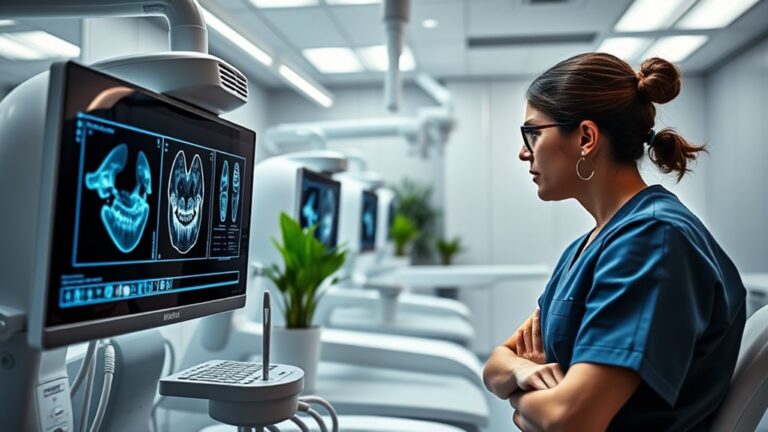Precision Digital Workflows Transform Modern Dental Prosthetic Design
You're likely aware that precision digital workflows are changing the landscape of dental prosthetic design, but have you considered how these advancements impact your practice? By utilizing tools like intraoral scanners and CAD/CAM systems, you can enhance accuracy and efficiency, streamlining the entire process. This not only benefits your workflow but also elevates patient experience. However, there's more to this transformation than meets the eye, particularly when it comes to the collaboration between dental teams and laboratories. What does this mean for the future of your practice and patient care?
If you're looking for guidance on implementing these technologies, feel free to reach out. We can connect you with experts who can provide tailored solutions to enhance your practice and patient care.
Digital Impressions and Accuracy
Digital impressions have revolutionized the way dental professionals capture the intricate details of a patient's oral anatomy, greatly enhancing accuracy in prosthetic design. You'll find that digital impressions generally provide superior outcomes in trueness, precision, and angle deviation compared to conventional methods.
One significant advantage is their resilience against distortion during removal, a common issue with traditional impression materials. This reliability allows for better-fitting restorations. Additionally, digital impressions are less affected by implant angulation, which can lead to more consistent results across varying clinical scenarios.
However, certain accuracy factors can influence the effectiveness of digital impressions. For example, inter-implant distance can negatively impact accuracy, particularly with larger spans. Additionally, the scanning protocol you choose plays a vital role; device-specific protocols must be followed for best results.
Factors such as implant angulation, depth, and location also come into play, affecting the overall accuracy of the impressions.
While recent intraoral scanners have shown clinically acceptable levels of accuracy, particularly for single implant restorations, they may not be suitable for larger inter-implant spans or edentulous jaws in routine practice.
Recognizing these limitations will help you better serve your patients, ensuring they receive the highest quality care.
Enhanced Efficiency in Workflows
Streamlining workflows in dental practices boosts efficiency and enhances the overall patient experience. By implementing streamlined processes and automated systems, you can greatly improve your practice's productivity and service quality.
Here are three key benefits of enhanced efficiency in workflows:
- Reduced Turnaround Times: Fast-tracking dental restorations allows you to deliver quicker care, leading to higher patient satisfaction.
- Optimized Resource Allocation: Efficient workflows enable you to manage increased case volumes without sacrificing quality, ensuring that your team can focus on patient care. Digital workflows contribute significantly to this optimization.
- Improved Communication: Automated systems facilitate seamless data sharing among front desk staff, dental teams, and laboratories, minimizing errors and fostering collaboration.
These improvements not only reduce paperwork but also help address bottlenecks in reception and operatories.
By integrating technologies like CAD/CAM and design thinking into your processes, you can continually optimize workflows and reduce manual tasks. This not only enhances productivity but also empowers your staff, allowing them to provide high-quality, timely care.
Ultimately, these enhancements position your practice to maintain a competitive edge while prioritizing exceptional patient service.
Technological Advancements in Dentistry
Advancements in dental technology have revolutionized the way practitioners diagnose and treat patients, leading to improved outcomes and enhanced experiences.
Modern imaging technologies, such as digital X-rays and 3D cone-beam computed tomography (CBCT), provide sharper images while greatly reducing radiation exposure. These tools enhance diagnostic accuracy, facilitating early detection of dental issues, especially in complex cases like implants or orthodontics.
Digital dentistry has taken a leap forward with intraoral scanners, which capture precise 3D images of teeth and gums in minutes, eliminating messy impressions. Coupled with CAD/CAM technology, you can design and manufacture custom crowns and bridges right in the office, streamlining processes and enhancing patient comfort.
Moreover, laser dentistry minimizes invasiveness, reducing pain and healing times for procedures like cavity removal and gum treatments. Incorporating augmented reality can further improve patient understanding and engagement during treatment discussions.
Additionally, teledentistry allows for remote consultations, expanding access to care and enabling you to serve patients better, regardless of location. Technological advancements in dentistry not only improve treatment precision but also empower patients to prioritize their oral health. Collectively, these advancements create a more efficient, patient-friendly environment, transforming how dental care is delivered.
Workflow Optimization Strategies
The integration of innovative technologies in dentistry is just the beginning; optimizing workflows is key to maximizing their benefits.
By focusing on specific strategies, you can enhance efficiency and improve patient care. Here are three effective workflow optimization strategies:
1. Administrative Automation: Implement dental practice management software to automate appointment scheduling, patient record management, and billing. This reduces manual errors and saves valuable time, allowing you to focus more on patient interactions. Additionally, streamlining administrative processes helps your practice operate more smoothly and efficiently.
2. Treatment Room Organization: Standardize the setup of instruments and supplies for common procedures. Arrange everything logically to minimize movement during treatments.
Regularly inspect and update your treatment room to guarantee all necessary tools are easily accessible, enhancing productivity.
3. Performance Monitoring: Establish performance metrics to evaluate productivity, such as chair utilization and patient satisfaction scores.
Regularly review these metrics and solicit team feedback to identify bottlenecks, adapting workflows as needed.
Patient-Centered Care Approaches
Patient-centered care approaches in dental practice prioritize the individual needs and preferences of each patient, leading to improved outcomes and satisfaction.
By employing a holistic approach, you can better assess how lifestyle factors, diet, and stress levels impact your patients' oral health. Understanding their unique experiences fosters empathy and enhances communication, which is essential for building trust and alleviating dental anxiety. Additionally, the use of advanced diagnostics enables precise understanding of dental structures and conditions, further tailoring care to individual needs.
Encouraging patient engagement is vital; invite them to ask questions and actively participate in their care. This involvement empowers them to make informed decisions about their treatment, ensuring they understand the risks and benefits of each option.
Tailoring treatment plans to reflect individual histories, preferences, and health conditions not only improves compliance but also aligns with their aesthetic and functional expectations.
Ultimately, by focusing on the whole person rather than just immediate dental concerns, you humanize the care experience.
This all-encompassing strategy not only aids in early detection and prevention of dental issues but also fosters a sense of ownership over their oral health, leading to better long-term outcomes and satisfaction.
Integration With Dental Laboratories
In today's dental practice, integrating digital workflows with dental laboratories is crucial for enhancing the overall efficiency and accuracy of prosthetic design. By leveraging advanced technologies, you can forge strong lab partnerships that streamline operations and improve patient outcomes.
Consider these key benefits of integration:
- Enhanced Accuracy: Utilizing CAD/CAM systems and intraoral scanners allows for precise digital impressions, minimizing errors associated with traditional methods. This improvement in accuracy is supported by AI algorithms that enhance diagnostic precision.
- Increased Productivity: Automation of tasks, such as digital designs and 3D printing, enables your lab to fabricate more restorations in less time while maintaining quality.
- Seamless Communication: Implementing lab management software guarantees smooth information flow, allowing real-time collaboration and reducing delays in case processing.
Investing in technology not only enhances your lab's capabilities but also fosters a more efficient workflow.
As you prioritize these integrations, you'll experience significant improvements in both the speed and quality of prosthetic design.
Collaboration Among Dental Teams
Effective integration with dental laboratories sets the stage for enhanced collaboration among dental teams. Interdisciplinary teamwork among prosthodontists, periodontists, oral surgeons, and general dentists is essential for successful prosthetic design and placement. By employing clear communication strategies, each discipline can share insights about their strengths and challenges, enabling the formulation of effective treatment plans.
For instance, dental technicians must understand the importance of design and compliance with oral hygiene management, as this reduces the risk of peri-implantitis. Regular at-home maintenance is vital for preventing periodontitis and peri-implantitis.
Cloud dentistry enhances this collaboration by facilitating asynchronous communication, allowing team members to evaluate, diagnose, and plan treatments without the need for constant in-person meetings.
Moreover, digital tools, such as the Straumann Prosthetic Selection Guide, streamline the selection of prosthetic components, reinforcing effective communication among team members.
Dental hygienists also play a significant role, providing patients with post-insertion instructions and emphasizing the importance of oral hygiene maintenance.
Ultimately, fostering an environment of collaboration through interdisciplinary communication not only improves patient outcomes but also guarantees that every team member is aligned in achieving long-term success in prosthetic care.
Impact of Advanced Materials
Advancements in materials science have revolutionized dental prosthetic design, enhancing both the functional and aesthetic aspects of restorations.
Material innovations have introduced a variety of options that provide durability, biocompatibility, and aesthetic enhancements, ensuring restorations not only perform well but also look natural. Digital imaging and advanced materials work together to ensure a seamless workflow, contributing to the overall effectiveness of dental prosthetics.
Here are three key materials transforming dental prosthetics:
1. Zirconia: This high-strength ceramic offers excellent durability and a natural translucency, making it ideal for crowns and bridges.
Its abrasion resistance and low thermal conductivity cater to patients with sensitivity.
2. Lithium Disilicate: Known for its strength and beauty, this glass-ceramic material is perfect for veneers and crowns.
It allows precise color matching, ensuring a perfect blend with the patient's natural teeth.
3. Titanium: As a biocompatible metal alloy, Titanium is widely used in dental implants.
Its robust nature and ability to osteointegrate with bone tissue provide stability and reduce plaque buildup.
These advanced materials not only elevate the quality of dental restorations but also greatly improve patient outcomes, showcasing the profound impact of modern material science in dentistry.
Future of Digital Prosthetic Design
The future of digital prosthetic design is poised for remarkable transformation, driven by innovations in technology and materials that enhance precision and patient outcomes.
As you incorporate personalized prosthetics into your practice, you'll witness significant time savings with same-day delivery options and fewer appointments. With AI-assisted design and predictive analytics, you can efficiently streamline clinical procedures, guaranteeing high-quality restorations with accurate fits.
The integration of advanced technologies like 3D printing and intraoral scanners will further revolutionize your workflow. These tools not only reduce manual errors but also provide precise fabrication, enhancing patient satisfaction. The rapid growth of 3D printing technology is expected to disrupt traditional manufacturing methods.
The ability to capture detailed 3D data will guarantee a clinically acceptable fit, minimizing the need for adjustments and improving overall comfort for your patients.
Moreover, cloud-based solutions will enable seamless collaboration and data transfer, enhancing your flexibility in treatment planning.
As you adopt these digital workflows, you'll find that they not only lower production costs but also elevate the quality of care you provide.
The ongoing evolution of digital prosthetic design promises to create a future where patient outcomes are consistently optimized, making your service more impactful than ever.
Frequently Asked Questions
How Do Digital Workflows Improve Patient Comfort During Procedures?
Digital workflows enhance patient experience by streamlining procedures, reducing discomfort associated with traditional methods. With improved workflow efficiency, you benefit from quicker, less invasive treatments, minimizing anxiety and creating a more pleasant environment during dental visits.
What Training Is Required for Dental Staff to Adopt Digital Technologies?
You might think digital literacy isn't essential, but it's vital for staff engagement. Training in digital tools, 3D printing, and advanced technologies equips your team to enhance patient care and streamline practice operations effectively.
Are There Specific Software Programs Preferred for Digital Prosthetic Design?
For digital prosthetic design, you'll prefer CAD software like Exocad or 3Shape. They offer design automation, simulation tools, and material selection, while integration platforms enhance compatibility with 3D printing and existing dental workflows.
How Do Digital Impressions Compare in Cost to Traditional Methods?
In your cost analysis, digital impressions offer better impression accuracy than traditional methods. While initial expenses are high, long-term savings from fewer remakes and faster treatments can greatly benefit both your practice and patients.
What Future Technologies Might Further Enhance Digital Prosthetic Workflows?
Future technologies like augmented reality and machine learning can revolutionize digital prosthetic workflows. You'll enhance treatment planning, improve precision in designs, and streamline processes, ultimately providing more effective and personalized care for your patients.
Conclusion
In the vibrant landscape of modern dentistry, precision digital workflows are like a finely tuned orchestra, harmonizing technology and artistry. By embracing digital impressions and advanced materials, you're not just enhancing accuracy; you're crafting bespoke solutions tailored to each patient's needs. As you collaborate seamlessly with dental laboratories and teams, you'll witness a transformation in outcomes and satisfaction.
However, navigating these advancements can be challenging. That's where we come in. By reaching out to us for assistance, you can save valuable time, reduce stress, and significantly improve your dental practice. Our expertise can guide you through the intricacies of digital workflows, ensuring that your practice stays at the forefront of dental prosthetic design.
The future of dental prosthetic design shines brightly, promising a world where every smile is a masterpiece, uniquely tailored for each individual. Let us help you make that future a reality.





